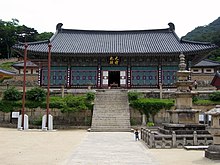Haein Temple
| UNESCO World Heritage Site | |
|---|---|
 |
|
| Location | South Gyeongsang Province, South Korea |
| Criteria | Cultural: iv, vi |
| Reference | 737 |
| Inscription | 1995 (19th Session) |
| Coordinates | 35°48′N 128°06′E / 35.800°N 128.100°E |
| Korean name | |
| Hangul | |
|---|---|
| Hanja | |
| Revised Romanization | Haeinsa |
| McCune–Reischauer | Haeinsa |
Coordinates: 35°48′N 128°6′E / 35.800°N 128.100°E Haeinsa (해인사, 海印寺: Temple of the Ocean Mudra) is a head temple of the Jogye Order (대한불교조계종, 大韓佛敎 曹溪宗) of Korean Seon Buddhism in Gayasan National Park (가야산, 伽倻山), South Gyeongsang Province, South Korea. Haeinsa is most notable for being the home of the Tripitaka Koreana, the whole of the Buddhist Scriptures carved onto 81,350 wooden printing blocks, which it has housed since 1398.
Haeinsa is one of the Three Jewels Temples, and represents Dharma or the Buddha’s teachings. It is still an active Seon (선, 禪) practice center in modern times, and was the home temple of the influential Seon master Seongcheol (성철, 性徹), who died in 1993.
The temple was first built in 802. Legend says that two Korean monks Suneung and Ijeong, returned from China and healed Aejang of Silla's wife of her illness. In gratitude for Gautama Buddha's mercy, the king ordered the construction of the temple. Another account, by Choe Chi-Won in 900 states that Suneung and his disciple Ijeong, gained the support of a queen dowager who converted to Buddhism and then helped to finance the construction of the temple.
...
Wikipedia

